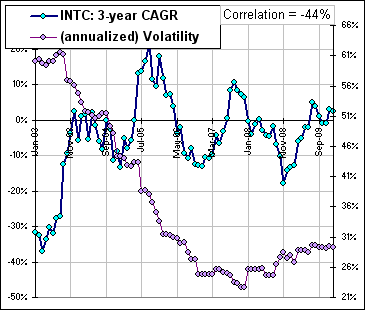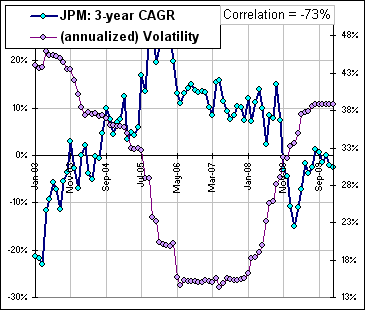| moving CAGR |
Here's an interesting notion. You take a gander at stock prices over, say, the last 10 years.
You notice that they went from P0 (10 years ago) to P1 (today).
If the Compound Annual Growth Rate is CAGR, then that means:
| CAGR = (P1 / P0)1/10 -1 |
>Huh?
That's because: P0 (1 + CAGR)10 = P1.
But suppose you'd like to see how that CAGR has changed over the years.
In fact, let's look at 3-year periods, where the stock price went from P0 to P1 over those 3 years.
Then the CAGR would be ...
>Don't tell me! It'd be (P1 / P0)1/3 -1
You got it.
Here's a spreadsheet where you can:
- Pick one of a gaggle of stocks
- Download 10 years worth of data
- Stare in awe at the variation in the CAGR (calculated over a moving 3-year period).

Click on the picture to download the spreadsheet.
In the example ...
>Wait! You've got Volatility?
Yes. It's the Standard Deviation based upon 3 years worth of monthly returns, multiplied by SQRT(12) to annualize. (See square root stuff.)
In the example, IBM has been downloaded and, over the entire 10-year period, the CAGR is 2.7%.
However, when calculated over 3 years, it's varied from -14.1% (over 3 years ending in Aug/03) to +21.3% (over 3 years ending in May/08).
Here are a few:



>Did you notice that Volatility seems to go in a direction opposite to the CAGR?
Fascinating, eh?
Here are a few stocks with their 3-year correlations:
| ^DJI -80% | ^IXIC -79% | AA -77% | AIG -83% | AXP -60% | BA -79% | C -89% | CAT -57% |
| DD -65% | DIS -62% | F 27% | GE -85% | HD -37% | HON -86% | HPQ -85% | IBM -68% |
| INTC -44% | JNJ 5% | JPM -73% | KO -71% | MCD -78% | MMM 32% | MO -3% | MRK -55% |
| MSFT -75% | PFE -12% | PG -45% | T -93% | UTX -49% | VZ -80% | WMT 16% | XOM 83% |